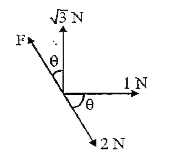Four concurrent coplanar forces in newton are acting at a point and keep it in equilibrium (figure). Then value of F and θ are

1N, 60∘
2N,60∘
√2M,90∘
2N,90∘
The correct Answer is:D
In equilibrium position
Along y-direction 2sin60∘=√3+Fcosθ
This gives, Fcosθ=0
As F≠0,∴cosθ=0⇒θ=90∘
Along x-diretion , Fsin90∘=1+2cos60∘⇒F=2
Similar Questions
Four forces acting on a particle keep it in equilibrium, then :-
View Solution(A) : A body subjected to three concurrent forces cannot be in equilibrium.
(R) : If large number of concurrent forces acting on the same point, then the point may be in equilibrium, even if the vectorial sum of all the force is not zero.
View Solution
Knowledge Check
Four co-planar concurrent forces are acting on a body as shown in the figure to keep it in equilibrium. The the values of P and θ are.
 AP=4N,θ=0∘BP=2N,θ=90∘CP=2N,θ=0∘DP=4N,θ=90∘
AP=4N,θ=0∘BP=2N,θ=90∘CP=2N,θ=0∘DP=4N,θ=90∘Four forces acting on a particle keep it in equilibrium, then :-
Athe force must be coplanar.Bthe force cannot be coplanarCthe forces may or may not be coplanar.Dif three of these forces are coplanar, so must be the fourth.Four forces act on a point object. The object will be in equilibrium, if
Aall of them are in the same planeBthey are opposite to each other in pairsCthe sum of x ,y and z components of force is zero seperatelyDthey can be represented by a closed figure of 4 sides by direction and magnitude
If four forces act at a point 'O' as shown in the figure and if O is in equilibrium then the value of 'θ' & 'P' are

View SolutionFour forces act on a point object. The object will be in equilibrium, if
View SolutionP,Q and R are three coplanar forces acting at a point and are in equilibrium. Given P=1N , sinθ1=12 , the value of R is

View SolutionP,Q and R are three coplanar forces acting at a point and are in equilibrium. Given P=1N , sinθ1=12 , the value of R is

View SolutionP, Q and R are three coplanar forces acting at a point and are in equilibrium. Given P=1.9318kg−wt,sinθ1=0.9659, the value of R is (∈kg−wt)

View Solution
